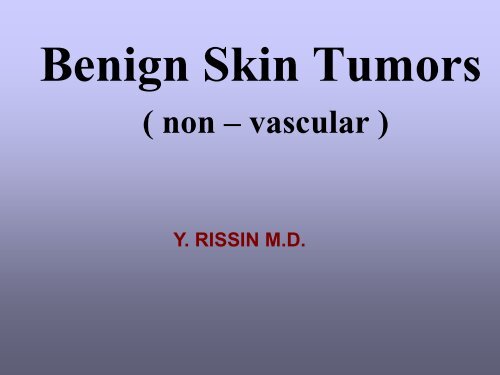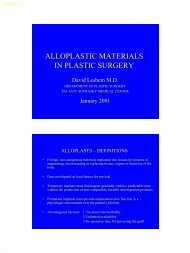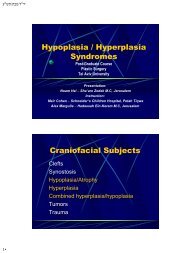Benign skin tumor ( non – vascular )
Benign skin tumor ( non – vascular )
Benign skin tumor ( non – vascular )
You also want an ePaper? Increase the reach of your titles
YUMPU automatically turns print PDFs into web optimized ePapers that Google loves.
<strong>Benign</strong> Skin Tumors<br />
( <strong>non</strong> <strong>–</strong> <strong>vascular</strong> )<br />
Y. RISSIN M.D.
VIRAL TUMORS<br />
VERRUCA VULGARIS<br />
• Small, raised, rough, clearly defined borders<br />
• Most likely on the fingers, hands and arms<br />
• Often appear in clusters around a "mother wart”<br />
• Causes - papilloma virus<br />
• Most common in children & young adults<br />
• Mildly contagious (person to person , area to area)<br />
• Treatment- Chemicals, Cryotherapy,<br />
Electrosurgery, Laser<br />
• Prognosis - spontaneous, recurrence
MOLLUSCUM CONTAGIOSUM<br />
• Molluscum contagiosum virus<br />
• Incubation period averages 2 to 3 months<br />
• Transmission - <strong>skin</strong>-to-<strong>skin</strong>, inanimate object<br />
• Sexually transmitted disease in adults<br />
• Treatment - self-resolving, surgically,<br />
chemical, cryotherapy, laser<br />
• Can last from 2 weeks to 4 years<br />
(average 2 years)
TUMORS OF THE<br />
EPIDERMIS<br />
SEBORRHEIC KERATOSIS<br />
(seborrheic wart, senile wart, basal cell papilloma)<br />
• Round/oval, yellow/brown/black slightly elevated,<br />
often waxy surface, rough or wart-like texture<br />
• Origin - unknown, not caused by exposure to<br />
sunlight or viruses<br />
• Light-<strong>skin</strong>ned persons after age 40<br />
• Usually painless & benign, may become irritated<br />
and itch
• Rapid growth - paraneoplastic syn.<br />
• D.D - melanoma<br />
• Treatment- usually is not required, may be removed<br />
surgically, cryotherapy, laser<br />
• Prognosis - benign, usually do not recur after removal
AKTINIC KERATOSIS<br />
(solar/senile keratosis)<br />
• Precancerous lesion caused by sun damage<br />
• Light brown macules, can be slightly elevated,<br />
feel rough, scaly<br />
• If untreated - can turn into cancer<br />
• Biopsy is recommended<br />
• Treatment - 5-FU, surgery, cryotherapy, laser
KERATOACANTHOMA<br />
(molluscum sebaceum)<br />
• Firm nodule, central keratotic plug<br />
• Ears, nose, cheeks, dorsum of the hands<br />
• <strong>Benign</strong>, develops rapidly, self healing<br />
• Difficult to distinguish from SCC<br />
• Treatment - usually regresses spontaneously<br />
in months, surgical excision is recommended<br />
(scar, rule out SCC)
EPIDERMAL CYSTS<br />
DERMOID CYST<br />
• Congenital hamartoma resulting from the<br />
entrapment of epidermis along the lines of<br />
embryonic fusion<br />
• Lateral ends of the eyebrows, along the<br />
midline in the nasal root, neck, sublingual,<br />
sternal, perineal, scrotal, and sacral areas<br />
• Of variable size<br />
• Treatment - complete excision<br />
• Preoperative CT (midline)
MILIA<br />
(Fullicular infundibular cyst)<br />
• Domed superficial cysts 1-2 mm<br />
• Uniform, pearly-white to yellowish, filled<br />
with keratin<br />
• Occur in all ages<br />
• Primary milia - infants, nose, may be on the<br />
mucosa and palate, (Epstein's pearls)<br />
• Secondary milia - blistering disorders,<br />
dermabrasion
• Primary milia arise in sebaceous glands that are not fully developed<br />
• Secondary milia due to disruption of the sweat duct<br />
• Treatment - no topical or systemic medications have any effect on milia<br />
• Can be safely left alone<br />
• Prognosis: primary milia in infancy tend to spontaneously<br />
disappear within the first few weeks of life. Secondary milia<br />
arising from blisters often do not resolve
ADNEXAL TUMORS<br />
SEBACEOUS TUMORS<br />
Sebaceous Hyperplasia<br />
• Small, round, up to 3 mm, flesh-colored/<br />
white/yellow, often have a central indentation<br />
• Enlarged sebaceous glands on the<br />
forehead/cheeks of the middle-aged/elderly<br />
• Treatment - light cautery, diathermy, laser<br />
• When severe, oral isotretinoin,antiandrogens,<br />
may improve the appearance
Nevus Sebaceus<br />
(organoid nevus)<br />
• Well-circumscribed, verrucose/finely nodular,<br />
orange, raised, irregular, hairless plaque<br />
• Scalp, face, neck<br />
• Present at birth and persists throughout life<br />
• Other <strong>tumor</strong>s tend to arise in these lesions<br />
(basal cell epithelioma 15%- 20%)<br />
• Treatment - excision during childhood
Nevus Verrucosus<br />
• Patchy/linear papillomatous, yellowish-tan<br />
keratotic plaque<br />
• Appears at birth or during childhood<br />
• Treatment - excision with a full thickness of<br />
<strong>skin</strong> to ensure that they do not recur, vitamin<br />
A analogs (reduce the degree of varicosity)
Epidermoid cysts<br />
• Dome-shaped, filled with semisolid material<br />
• Trunk, face, neck, scalp<br />
• Most common in adolescents and adults<br />
• Can be injured or infected<br />
• Causes <strong>–</strong> epidermal cells being trapped in<br />
the dermis (plugged ducts)<br />
• Treatment <strong>–</strong> removal<br />
• Complications - infection, rupture
HAIR FOLLICLE TUMORS<br />
Pilomatrixoma<br />
• Firm, deep-seated nodule<br />
• Head, neck and upper extremities<br />
• Made up of hair precursor cells<br />
• Treatment - excision
Trichoepithelioma<br />
• Uncommon, arise on the face after puberty<br />
• Single or multiple benign <strong>tumor</strong>s<br />
• Small < 1cm, firm, rounded, shiny, yellow,<br />
pink, brown or bluish<br />
• Both cheeks, eyelids, around the nose<br />
• Gradually increase in number with age
• Treatment - Individual lesions may be removed surgically if<br />
there is any suspicion of malignant change<br />
• Laser & dermabrasion may improve the appearance but partial<br />
destruction of the <strong>tumor</strong> is usually followed by regrowth
Pilar Cyst<br />
(wens cysts, tricholemmal cysts)<br />
• Resemble epidermoid cysts<br />
• Scalp (90%)<br />
• Contain <strong>non</strong>lamellous keratinous<br />
material<br />
• Occurrence of large numbers - look for<br />
Gardner’s syndrome
SWEAT GLAND TUMORS<br />
Syringoma<br />
• Skin-colored/slightly yellow papules, 1<strong>–</strong>3 mm<br />
• Adenoma of the intraepidermal eccrine duct<br />
• Usually presents as multiple lesions at puberty<br />
• Symmetrically on the eyelids, cheeks, axilla,<br />
umbilicus and pubic area<br />
• Treatment - excision, laser, light<br />
electrodessication
Eccrine Poroma<br />
• Dome-shaped, polypoid/verrrucoid 1-10cm<br />
• Single <strong>tumor</strong>, sole/sides of the foot<br />
• Usually occurs after the age of 40<br />
• On rare occasions, may develop into a<br />
porocarcinoma or malignant eccrine poroma<br />
• Malignant transformation - ulcers, rapid<br />
growth, multinodular growth, bleeding<br />
• Treatment - excision
Hydradenoma Papilliferum<br />
• Have a tendency to ulcerate<br />
• Can easily be mistaken for a carcinoma<br />
• Treatment - excision
Cylindroma<br />
(turban <strong>tumor</strong>)<br />
• Round/lobulated, firm, pink nodules<br />
• Solitary & multiple forms<br />
• Multiple lesion occur as an autosomal<br />
dominant inherited<br />
• Solitary - not inherited<br />
• Most common in the scalp<br />
• Treatment <strong>–</strong> complete excision
DERMAL TUMORS<br />
DERMATOFIBROMA<br />
(histiocytoma, nodulus cutaneus, sclerosing<br />
angioma, lipoidal histiocytoma, fibroma simplex,<br />
fibroma durum)<br />
• A firm, pea-sized, slightly elevated, fleshtoned<br />
to purplish or dusty brown<br />
• The cause is not known<br />
• Common in adults, rarely in children<br />
• Treatment - can be removed completely<br />
(surgically excised), or only the elevated<br />
portion can be removed
SKIN TAGS<br />
(acrochordon, soft fibroma, cutaneous tags)<br />
• Common, occur most often after midlife<br />
• Tiny <strong>skin</strong> protrusions, may have a small<br />
narrow stalk<br />
• Painless, do not grow or change<br />
• Neck, armpits,trunk, body folds or other<br />
area<br />
• Treatment - not necessary unless the<br />
tags are irritating or are cosmetically<br />
displeasing
TUMOR OF NEURAL TISSUE<br />
GRANULAR CELL MYOBLASTOMA<br />
(granular cell schwannoma)<br />
• It is not clear whether or not it is a true neoplasm,<br />
a developmental anomaly, or a trauma-induced<br />
proliferation<br />
• Widely distributed throughout the body, 50%<br />
occur in the oral cavity<br />
• Malignant variants represent approximately 1%<br />
of all cases<br />
• Usually as a sessile, painless, firm,<br />
immovable nodule < 1.5 cm, smooth surface
• Pallor or a yellowish discoloration<br />
• Treatment - conservative excision<br />
• Recurrence is seen in fewer than 7% of cases even if granular<br />
cells extend beyond the surgical margins of the biopsy sample
NEUROFIBROMA<br />
• Unknown origin, may occur in peripheral<br />
nerve, soft tissue, <strong>skin</strong> or bone<br />
• Firm, gray-white mass with no capsule<br />
• Vary in size from a few millimeters to 5 cm<br />
• Solitary lesion more common than multiple<br />
• Solitary lesions most commonly present<br />
from age 20 to 30 and often arise as<br />
superficial painless mass in the dermis
• Neurofibromas that occur as part of von Recklinghausen's disease are<br />
generally larger and have a 4% chance of malignant transformation<br />
• Treatment, if necessary, is surgical excision
MISCELLANEOUS<br />
LIPOMA<br />
• Made up of fat cells<br />
• Smooth, fluctuant lumps under the <strong>skin</strong><br />
• Rarely painful<br />
• Treatment - normally no treatment is required
XANTHELASMA & XANTHOMA<br />
• Common among older adults and persons with<br />
elevated blood lipids<br />
• Xanthelasmas - usually under the <strong>skin</strong> of the<br />
eyelids near the nose<br />
• Xanthomas - can appear anywhere, commonly<br />
on the elbows, joints, tendons, knees, hands, feet<br />
or buttocks<br />
• Ranging in size from very small to<br />
more than 8 cm<br />
• Treatment - if necessary, is surgical<br />
excision, laser
MUCOUS CYSTS<br />
• Rapid development of soft, rounded<br />
cyst, 2 to 10 mm<br />
• Small, <strong>non</strong> painful, deposits of fatty<br />
materials under the surface of the <strong>skin</strong><br />
• Surface is made up of translucent mucosa<br />
• Most often occurring inside the<br />
lower lip<br />
• Caused by traumatic rupture of the mucus<br />
gland duct with extravasation of<br />
sialomucin into the submucosa<br />
• Treatment - laser, total cyst excision
MYXOID CYSTS<br />
(mucous cyst of finger or toes)<br />
• Cystic lesion (actually a ganglion) over<br />
dorsum of finger near DIP & fingernail<br />
• May or may not be connected to DIP joint by<br />
a synovial stalk<br />
• May be associated with grooving of<br />
fingernail distal to the cyst<br />
• Usually flesh colored and compressible
• Treatments <strong>–</strong> Cryotherapy, steroid injection, sclerosant<br />
injection, surgical removal<br />
• Unfortunately, mucous cysts often recur,<br />
whatever treatment is used
PIGMENTARY SYSTEM
Melanocytes & Skin Color<br />
• The melanin pigmentary system is<br />
composed of functional units -<br />
epidermal melanin units<br />
• Each unit consists of a<br />
melanocyte that supplies<br />
melanin pigment to a group of<br />
keratinocytes (about 36)<br />
• Pigmentation is determined primarily by<br />
the amount of melanin transferred to the<br />
keratinocytes
• Melanosomes are membrane-bound organelles located in the<br />
cytoplasm of melanocytes and bearing tyrosinase enzyme.<br />
They are responsible for melanin synthesis and pigment<br />
transfer from the melanocyte to the surrounding keratinocytes<br />
• Pigment transfer occurs by keratinocyte<br />
phagocytosis of melanosome<br />
• The differences in racial pigmentation<br />
are not due to differences in the number<br />
of melanocytes, but rather to<br />
differences in melanocyte activity<br />
• Melanin is a brown-black, lightabsorbing<br />
pigment, protecting<br />
the <strong>skin</strong> against ultraviolet rays
• The melanocyte is a dendritic cell present<br />
in the basal layer of the epidermis<br />
• Melanocytes arise from the neural crest<br />
as melanoblasts and migrate to the<br />
dermis, hair follicles, leptomeninges,<br />
uveal tract and retina<br />
• By the 8th week of intrauterine life,<br />
they start to migrate from the dermis<br />
to the epidermis<br />
• Although full melanocyte migration is normally<br />
completed prior to birth, residual dermal<br />
melanocytes are sometimes left (clinically<br />
appearing as mongoloid spots in the sacral area<br />
of oriental and black infants)
PIGMENTED LESIONS<br />
FRECKLES (ephelides)<br />
• Flat, small brown spot on a sun-exposed area<br />
• Usually multiple in number.<br />
• If a freckle changes significantly, it should<br />
be examined<br />
• Most freckles are medically unimportant<br />
• Cosmetic removal of freckles by laser
LENTIGINES<br />
(Sun spots, age spots, liver spots)<br />
• Flat, brown discolorations of the <strong>skin</strong><br />
• Usually occur on the back of the hands,<br />
neck & face of people older than 40 years<br />
• Are caused by exposure sun over years<br />
• Prevention - sunscreen<br />
• Treatment - alpha hydroxy & beta<br />
hydroxy acid gel, retin-A, topical vitamin<br />
C, alpha hydroxyacid peel, Liquid<br />
nitrogen therapy
NEVUS CELL NEVUS<br />
JUNCTIONAL NEVUS<br />
• Usually multiple<br />
• Can occur on any part of the body<br />
• Histologically the nests of melanocytes are<br />
confined to the dermo-epidermal junction
COMPOUND NEVUS<br />
• Common, raised and pigmented mole,<br />
usually dome-shaped papules, may become<br />
pedunculated<br />
• Often present on the face or trunk<br />
• Varies from barely tan to dark brown<br />
• Histologically, the nests of melanocytes are<br />
both at the dermo-epidermal junction and in<br />
the underlying dermis
INTADERMAL NEVUS<br />
• Usually dome-shaped<br />
• Found most often on the scalp, hand,<br />
and neck of adults<br />
• Histologically the nests of melanocytes<br />
are confined to the dermis
BLUE NEVUS<br />
• Variant of a common mole<br />
• Gets its name from the distinct appearance<br />
• Usually present at birth but can develop later<br />
• There are 3 types of blue nevus:<br />
1.Common blue nevus<br />
2.Cellular blue nevus<br />
3.Combined blue nevus <strong>–</strong> nevomelanocytic<br />
nevus
• Common blue nevus - a small bluish gray papule commonly over<br />
the hands and feet. It develops later in life<br />
• Cellular blue nevus - bigger in size reaching up to 3 cm<br />
• Combined blue nevus and melanocytic nevus - present as bluish<br />
gray nodules or plaques, may be present at birth or later in life<br />
• Treatment - any blue nevus which has not changed recently can<br />
be left alone
HALO NEVUS<br />
(leukoderma acquisitum centrifigum, Nevus of Sutton)<br />
• Pink or brown, surrounded by an area of white<br />
or light <strong>skin</strong><br />
• The halo is depigmented <strong>skin</strong><br />
• Usually seen in young people<br />
• The mole portion tends to flatten and may<br />
disappear completely<br />
• The white area may stay if the mole disappears,<br />
or the normal <strong>skin</strong> color may return
• Occurs when the immune cells attack a mole for unknown reasons<br />
• Are sometimes seen in people with vitiligo or may occur in patients<br />
with malignant melanoma<br />
• Atypical moles are more common on people with halo nevi<br />
• Treatment - normally no treatment is required<br />
• A yearly complete <strong>skin</strong> exam is recommended for those with halo<br />
nevi or a single halo nevus to make sure there are no atypical moles<br />
or malignant melanoma
DYSPLASTIC NEVUS<br />
(atypical nevus, Clark's nevus)<br />
• An acquired mole that may appear as<br />
solitary or multiple lesions<br />
• Usually appear in adolescence on the<br />
back, chest, abdomen, buttocks, scalp.<br />
• Seen in about 4% of the white population<br />
• The tendency to develop dysplastic nevi<br />
is familial
• More than 5 mm in diameter, at least partly flat, has two of the<br />
following three characteristics:<br />
1. Variable coloring<br />
2. Asymmetrical outline<br />
3. Irregular borders<br />
• Someone with a dysplastic nevus is considered to have an<br />
increased lifetime risk for melanoma<br />
• Treatment - routinely evaluation by (once or twice a year)<br />
removing all of these moles is neither practical nor recommended<br />
• Relatives of persons with dysplastic nevi and melanoma<br />
should be examined more frequently
CONGENITAL GIANT (Hairy)<br />
PIGMENTED NEVUS<br />
(bathing trunk nevus)<br />
• Present at birth as large continuous areas<br />
of multiple discrete patches of pigment,<br />
often verrucous, often extremely hairy<br />
• May be associated with abnormalities<br />
(spina bifida, meningocele, other nevi,<br />
neurofibromatosis)<br />
• May eventually develop melanoma<br />
with an incidence of 15%<br />
• Surgical excision is recommended
SPINDEL & EPITHELIOID CELL NEVUS<br />
(spits nevus, benign Juvenile Melanoma)<br />
• <strong>Benign</strong>, elevated, pink to purplish-red<br />
papule, with a slightly scaly surface<br />
• Usually appears on the face, especially the<br />
cheeks, trunk, and extremities<br />
• Most often occurs before puberty<br />
• Has been mistaken for M.M<br />
• Difficult to distinguish from melanoma<br />
(atypical melanocytes)
OTA’S NEVUS<br />
(oculodermal melanocytosis)<br />
• Hyper pigmentation of certain ocular tissues<br />
and the <strong>skin</strong>, usually in the territory of the<br />
first and second division of the fifth cranial<br />
nerve, usually unilateral<br />
• Some patients may manifest dermal<br />
involvement alone, others may have only<br />
ocular changes<br />
• Although the condition is congenital, the level<br />
of pigmentation becomes more intense at<br />
puberty and in pregnancy
• Sequelae - glaucoma, malignant melanoma<br />
• M.M can occur at a variety of tissue sites including the uveal tract,<br />
orbit, dura and the central nervous system<br />
• Treatment - Q-switched lasers, liquid nitrogen cryotherapy,<br />
dermabrasion, YAG laser
BACKER’S NEVUS<br />
• Uncommon pigmented smooth muscle<br />
hamartoma<br />
• Develops during adolescence and occurs<br />
primarily in young men<br />
• Hypertrichosis and hyper pigmentation<br />
• Usually unilaterally over the shoulder,<br />
upper arm, and scapula<br />
• Treatment, if necessary, is excision, laser
THANK YOU !












